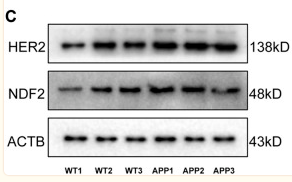NDF2 Antibody - #AF0635
| Product: | NDF2 Antibody |
| Catalog: | AF0635 |
| Description: | Rabbit polyclonal antibody to NDF2 |
| Application: | WB IHC IF/ICC |
| Reactivity: | Human, Mouse, Rat |
| Prediction: | Pig, Bovine, Horse, Dog |
| Mol.Wt.: | 48kDa; 41kD(Calculated). |
| Uniprot: | Q15784 |
| RRID: | AB_2834265 |
Related Downloads
Protocols
Product Info
*The optimal dilutions should be determined by the end user.
*Tips:
WB: For western blot detection of denatured protein samples. IHC: For immunohistochemical detection of paraffin sections (IHC-p) or frozen sections (IHC-f) of tissue samples. IF/ICC: For immunofluorescence detection of cell samples. ELISA(peptide): For ELISA detection of antigenic peptide.
Cite Format: Affinity Biosciences Cat# AF0635, RRID:AB_2834265.
Fold/Unfold
bHLHa1; class A basic helix loop helix protein 1; Class A basic helix-loop-helix protein 1; NDF2_HUMAN; NDR2; NDRF; neuroD related factor; NeuroD-related factor; NeuroD2; neurogenic basic helix loop helix protein; neurogenic differentiation 2; Neurogenic differentiation factor 2; neuronal differentiation 2;
Immunogens
- Q15784 NDF2_HUMAN:
- Protein BLAST With
- NCBI/
- ExPASy/
- Uniprot
MLTRLFSEPGLLSDVPKFASWGDGEDDEPRSDKGDAPPPPPPAPGPGAPGPARAAKPVPLRGEEGTEATLAEVKEEGELGGEEEEEEEEEEGLDEAEGERPKKRGPKKRKMTKARLERSKLRRQKANARERNRMHDLNAALDNLRKVVPCYSKTQKLSKIETLRLAKNYIWALSEILRSGKRPDLVSYVQTLCKGLSQPTTNLVAGCLQLNSRNFLTEQGADGAGRFHGSGGPFAMHPYPYPCSRLAGAQCQAAGGLGGGAAHALRTHGYCAAYETLYAAAGGGGASPDYNSSEYEGPLSPPLCLNGNFSLKQDSSPDHEKSYHYSMHYSALPGSRPTGHGLVFGSSAVRGGVHSENLLSYDMHLHHDRGPMYEELNAFFHN
Predictions
Score>80(red) has high confidence and is suggested to be used for WB detection. *The prediction model is mainly based on the alignment of immunogen sequences, the results are for reference only, not as the basis of quality assurance.
High(score>80) Medium(80>score>50) Low(score<50) No confidence
PTMs - Q15784 As Substrate
| Site | PTM Type | Enzyme | Source |
|---|---|---|---|
| S7 | Phosphorylation | Uniprot | |
| S20 | Phosphorylation | Uniprot | |
| K156 | Ubiquitination | Uniprot | |
| Y169 | Phosphorylation | Uniprot | |
| S212 | Phosphorylation | Uniprot |
Research Backgrounds
Transcriptional regulator implicated in neuronal determination. Mediates calcium-dependent transcription activation by binding to E box-containing promoter. Critical factor essential for the repression of the genetic program for neuronal differentiation; prevents the formation of synaptic vesicle clustering at active zone to the presynaptic membrane in postmitotic neurons. Induces transcription of ZEB1, which in turn represses neuronal differentiation by down-regulating REST expression. Plays a role in the establishment and maturation of thalamocortical connections; involved in the segregation of thalamic afferents into distinct barrel domains within layer VI of the somatosensory cortex. Involved in the development of the cerebellar and hippocampal granular neurons, neurons in the basolateral nucleus of amygdala and the hypothalamic-pituitary axis. Associates with chromatin to the DPYSL3 E box-containing promoter (By similarity).
Nucleus.
Interacts with TCF3, TCF4 and TCF12. Interacts with CDC20. Efficient DNA-binding and transcription activation require dimerization with another bHLH protein (By similarity).
The C-terminal region is necessary for depolarization-induced and calcium-dependent transcription activation.
References
Application: IF/ICC Species: Mouse Sample: brain tissue
Application: WB Species: Mouse Sample: brain tissue
Restrictive clause
Affinity Biosciences tests all products strictly. Citations are provided as a resource for additional applications that have not been validated by Affinity Biosciences. Please choose the appropriate format for each application and consult Materials and Methods sections for additional details about the use of any product in these publications.
For Research Use Only.
Not for use in diagnostic or therapeutic procedures. Not for resale. Not for distribution without written consent. Affinity Biosciences will not be held responsible for patent infringement or other violations that may occur with the use of our products. Affinity Biosciences, Affinity Biosciences Logo and all other trademarks are the property of Affinity Biosciences LTD.


